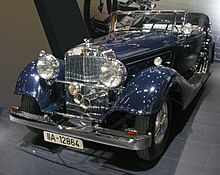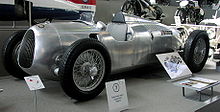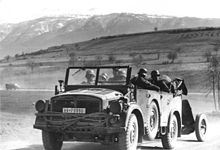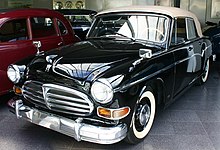Horch
This articleneeds additional citations forverification.(October 2018) |
 | |
| Industry | Automotive |
|---|---|
| Founded | 1904 |
| Defunct | 1932 1959 |
| Fate | merged withDKW,Wanderer,andAudito formAuto Union |
| Successor | Auto Union (1932–1969) Audi NSU Auto Union (1969–1985) Audi AG (1985–present) |
| Headquarters | Zwickau,Saxony,Germany |
Key people | August Horch,founder |
| Products | Luxury cars |

Horch(German pronunciation:[hɔʁç]) was a German car manufacturer, which traced its roots to several companies founded in the very late 19th and early 20th century byAugust Horch.
It is one of the predecessors of the present dayAudicompany, which itself resulted from themergerofAuto UnionAktiengesellschaft(AG) andNSU Motorenwerkein 1969. Auto Union AG in turn was formed in 1932, following themergerof Horch,DKW,Wandererand the original Audi Automobilwerke GmbH Zwickau, established by August Horch in 1910.
In 2021, Audi reused the Horch name as a flagship trim level for theAudi A8in China to compete with theMercedes-Maybach S-Class.[1]
History at a glance
[edit]



August Horchand his first business partner Salli Herz established the company on November 14, 1899 in the district ofEhrenfeld, Colognein Cologne.[2]August Horch had previously worked as aproduction managerforKarl Benz.Three years later, in 1902, he moved the company toReichenbach im Vogtland.On May 10, 1904 he founded theHorch & Cie. Motorwagenwerke AG,a joint-stock company inZwickau(Kingdom of Saxony). The city of Zwickau was the capital of the South Western Saxon County and one ofSaxony's industrial centres at that time.
After troubles with the Horch chief financial officer, August Horch founded a second company on 16 July 1909, theAugust Horch Automobilwerke GmbHin Zwickau. He had to rename the company becauseHorchwas already a registered brand and he did not hold the rights to the name. On 25 April 1910 the nameAudi Automobilwerkewas entered in the company's register at the Zwickau registration court.Audiis the Latin translation ofhorch,from the German verb "horchen", which means "listen!" (compare English "hark" ). The Audi name was proposed by a son of one of Horch's business partners from Zwickau.[3]
In 1932 both companies from Zwickau (Horch and Audi) merged with Zschopauer MotorenwerkeJ. S. Rasmussen(theDKWbrand) and theWanderercar-production facilities to become theAuto Unioncorporation of Saxony. TheSilver Arrowracing cars of the Auto Union racing team in Zwickau—developed byFerdinand PorscheandRobert Eberan von Eberhorst,and driven byBernd Rosemeyer,Hans Stuck,Tazio NuvolariandErnst von Delius—became known the world over in the 1930s.
Initial cars
[edit]The company initially began producing 5hp(3.7 kW; 5.1 PS) and 10 hp (7.5 kW; 10 PS) twin-cylinder engine automobiles nearColognein 1901.
The first Horch had a 4.5 hp (3.4 kW; 4.6 PS) engine, with an alloy crankcase, a unique achievement in those days. It had an open-body design, with lighting provided by lanterns containing candles. In contrast with the powerful cars of later years, the first Horch could barely reach a top speed of 32 km/h (20 mph). It was significant at that time because it used a friction clutch, and had a drive shaft providing power to the wheels.
The firm soon encountered financial difficulty, and Horch sought new partners.
In March 1902, August Horch produced a 20 hp (15 kW; 20 PS) four-cylinder car with a shaft drive in Reichenbach in Vogtland. Horch cars were considered[by whom?]more advanced to those being built byMercedesorBenz(who were then separate manufacturers).
By 1903, Horch had built a car with a four-cylinder engine. In March of the following year, he introduced his new car at theFrankfurtFair.
In 1904, August Horch developed the first six-cylinder engine, which appeared in 1907. In 1906 a Horch automobile driven by Dr. Rudolf Stöss from Zwickau won the Herkomer Competition (equivalent to a 'brand-name' world championship at the time). In the 1920s, Moritz Stauss, a cosmopolitan Berliner, was the principal stockholder of the Horch company. He succeeded in making the Horch brand highly desirable by introducing art into the firm's advertising. He recognized that only a brand emphasising Horch's unique characteristics would be successful.
In 1923,Paul Daimler(a Stauss associate) worked for Horch as the chief engineer for 8-cylinder engines. Horch vehicles were subsequently the first to introduce 8-cylinder engines in series production.[citation needed]
Audi connection
[edit]In 1909, the supervisory board (the German equivalent of the Board of Directors) of the corporation forced out Horch. Horch went on to foundAudias Audiwerke GmbH, which became effective on 25 April 1910. The name was a solution to the legal dispute with his old company over use of the Horch brand and a clever play of words ( "audi" is the literal Latin translation of theOld German"horch", meaning the imperative "Listen!" ).
In 1928, the company was acquired byJørgen Skafte Rasmussen,owner ofDKW(from the GermanDampfkraftwagen,or steam engine vehicle) who had bought the remains of the US automobile manufacturerRickenbackerin the same year. The Rickenbacker purchase included their manufacturing equipment for eight-cylinder engines.
Auto Union
[edit]
Eventually, on 29 June 1932, Horch, Audi,DKWandWanderermerged to form theAuto Union.The current Audi four-ring logo is the Auto Union logo that represents the merger of these four brands. In the 1930s, Horch introduced a new line of smaller and cheaper, but still presentable, V8 automobiles. In 1936, Horch presented the 25,000th 8-cylinder luxury car inZwickau.
The Auto UnionGrand Prix racing carstypes A to D, were developed and built by a specialist racing department of Horch works inZwickaubetween 1933 and 1939. Between 1935 and 1937 Auto Union cars won 25 races, driven byErnst von Delius,Tazio Nuvolari,Bernd Rosemeyer,Hans StuckandAchille Varzi.

Auto Union became a major supplier of vehicles to the GermanWehrmacht,such asHeavy standard passenger car(Horch 108),Medium standard passenger car(Horch 901 and Wanderer 901) andHalf-trackSd.Kfz. 11.Civilian production was suspended after March 1940. After the war the Auto Union AG at Chemnitz was dissolved and in Ingolstadt, West Germany the new Auto Union GmbH was founded, where civilian car production continued. Due to widespread poverty in postwar Germany, only small DKW vehicles with two stroke engines were produced. After Auto Union was purchased in 1964 by theVolkswagenwerk AG,the old brandAudiwas introduced again, together with the new four stroke vehicleAudi F103.Daimler-Benz retained the trademark rights to the Horch brand until the mid 1980s. Daimler-Benz then transferred the rights to the Horch brand name to Audi which in turn signed a waiver to use the name „Silberpfeil “(silver-arrow) for any modern Audi racing car. However, the brand has remained dormant.
TheRomanian Armypurchased 300 Horch 901 4x4 field cars to mechanize some of its anti-tank companies.[4]
Trabant connection
[edit]During theSecond World War,the factories suffered heavy bomb damage. Later, the advancingSovietforces captured the area, and it became part of theSoviet sector of divided Germanyin 1945, and later became part ofEast Germany.

From 1955 to 1958, old Horch factories produced the Horch P240, a six-cylinder car that was respected at the time. The former Horch andAudioperations from Zwickau were unified in 1958. A new brand,Sachsenring,within the East German corporationIFAwas born. After unification in 1958, the P240 car was renamed as theSachsenring P240.As the Soviet Administration inexplicably banned the foreign exportation of the P240, the East German economic administration decided to stop production of the vehicle. IFA also produced the initialTrabant"P-50" model from 1957.[5]
The Zwickau site was acquired in 1991 byVolkswagen,effectively restoring its connection with Audi. In1991,Volkswagen constructed a new factory to the north of Zwickau in nearby Mosel.
Rare collectibles
[edit]On June 24, 2006, a rare 1937 Horch 853A Sport Cabriolet in original unrestored, unprepared condition sold at auction in Cortland, NY for US$299,000.[6]
In the late 1930s, Horch supplied a limited number of promotional scarves bearing the Horch logo. Sent only to the wealthiest drivers, it is a major collectible amongst diehard enthusiasts of the pre-war car era. However, there is also a degree of controversy associated with these scarves as they were commonly sought by senior SS members.


Horch models
[edit]| Type | Construction | Cylinders | Displacement | Power | Top speed |
|---|---|---|---|---|---|
| 4-15 PS | 1900–1903 | straight-2 | 2.9-3.7 kW | 60 km/h (37 mph) | |
| 10-16 PS | 1902–1904 | straight-2 | 7.4-8.8 kW | 62 km/h (39 mph) | |
| 22-30 PS | 1903 | straight-4 | 2,725 cc | 16.2-18.4 kW | |
| 14-20 PS | 1905–1910 | straight-4 | 2,270 cc | 10.3-12.5 kW | |
| 18/25 PS | 1904–1909 | straight-4 | 2,725 cc | 16.2 kW | |
| 23/50 PS | 1905–1910 | straight-4 | 5,800 cc | 29 kW | 100 km/h (62 mph) |
| 26/65 PS | 1907–1910 | straight-6 | 7,800 cc | 44 kW | 120 km/h (75 mph) |
| 25/60 PS | 1909–1914 | straight-4 | 6.395 cc | 40 kW | 110 km/h (68 mph) |
| 10/30 PS | 1910–1911 | straight-4 | 2,660 cc | 18.4 kW | |
| K (12/30 PS) | 1910–1911 | straight-4 | 3,177 cc | 20.6 kW | 75 km/h (47 mph) |
| 15/30 PS | 1910–1914 | straight-4 | 2,608 cc | 22 kW | 80 km/h (50 mph) |
| H (17/45 PS) | 1910–1919 | straight-4 | 4,240 cc | 33 kW | |
| 6/18 PS | 1911–1920 | straight-4 | 1,588 cc | 13.2 kW | |
| 8/24 PS | 1911–1922 | straight-4 | 2,080 cc | 17.6 kW | 70 km/h (43 mph) |
| O (14/40 PS) | 1912–1922 | straight-4 | 3,560 cc | 29 kW | 90 km/h (56 mph) |
| Pony (5/14 PS) | 1914 | straight-4 | 1,300 cc | 11 kW | |
| 25/60 PS | 1914–1920 | straight-4 | 6,395 cc | 44 kW | 110 km/h (68 mph) |
| 18/50 PS | 1914–1922 | straight-4 | 4,710 cc | 40 kW (55 PS) |
100 km/h (62 mph) |
| S (33/80 PS) | 1914–1922 | straight-4 | 8,494 cc | 59 kW | |
| 10 M 20 (10/35 PS) | 1922–1924 | straight-4 | 2,612 cc | 25.7 kW | 80 km/h (50 mph) |
| 10 M 25 (10/50 PS) | 1924–1926 | straight-4 | 2,612 cc | 37 kW | 95 km/h (59 mph) |
| 8 Typ 303/304 (12/60 PS) | 1926–1927 | straight-8 | 3,132 cc | 44 kW | 100 km/h (62 mph) |
| 8 Typ 305/306 (13/65 PS) | 1927–1928 | straight-8 | 3,378 cc | 48 kW | 100 km/h (62 mph) |
| 8 Typ 350/375/400/405 (16/80 PS) | 1928–1931 | straight-8 | 3,950 cc | 59 kW | 100 km/h (62 mph) |
| 8 3 L Typ 430 | 1931–1932 | straight-8 | 3,009-3,137 cc | 48 kW (65 PS) |
100 km/h (62 mph) |
| 8 4 L Typ 410/440/710 | 1931–1933 | straight-8 | 4,014 cc | 59 kW (80 PS) |
100–110 km/h (62–68 mph) |
| 8 4.5 L Typ 420/450/470/720/750/750B | 1931–1935 | straight-8 | 4,517 cc | 66 kW (90 PS) |
115 km/h (71 mph) |
| 8 5 L Typ 480/500/500A/500B/780/780B | 1931–1935 | straight-8 | 4,944 cc | 74 kW (100 PS) | 120–125 km/h (75–78 mph) |
| 12 6 L Typ 600/670 | 1931–1934 | V12 | 6,021 cc | 88 kW (120 PS) | 130–140 km/h (81–87 mph) |
| 830 | 1933–1934 | V8 | 3,004 cc | 51 kW (70 PS) | 110–115 km/h (68–71 mph) |
| 830B | 1935 | V8 | 3,250 cc | 51 kW (70 PS) | 115 km/h (71 mph) |
| 830Bk/830BL | 1935–1936 | V8 | 3,517 cc | 55 kW (75 PS) | 115–120 km/h (71–75 mph) |
| 850/850 Sport | 1935–1937 | straight-8 | 4,944 cc | 74 kW (100 PS) | 125–130 km/h (78–81 mph) |
| 830BL/930V | 1937–1938 | V8 | 3,517 cc | 60 kW (82 PS) | 120–125 km/h (75–78 mph) |
| 830BL/930V | 1938–1940 | V8 | 3,823 cc | 67.6 kW (92 PS) | 125–130 km/h (78–81 mph) |
| 851/853/853A/855/951/951A | 1937–1940 | straight-8 | 4,944 cc | 74 kW (100 PS) | 125–140 km/h (78–87 mph) |
See also
[edit]References
[edit]- ^"Audi A8 L Horch Breaks Cover Ahead Of Chinese Debut Next Month".Motor1.com.Retrieved2021-10-30.
- ^August Horch: "Ich baute Autos - Vom Schmiedelehrling zum Autoindustriellen", Schützen-Verlag Berlin 1937
- ^Audi AG motion picture 1994: 'The Silver Arrows from Zwickau,running time approx. 49 mins.
- ^Tarnstrom, Ronald L. (1998).Balkan Battles.Trogen Books.ISBN9780922037148.RetrievedApr 14,2019– via Google Books.
- ^"Trabant History".Trabant.shocauto.com. Archived fromthe originalon 2010-09-29.Retrieved2010-10-02.
- ^"Rm Auctions".Rm Auctions. Archived fromthe originalon 2010-09-29.Retrieved2010-10-02.
Further reading
[edit]- Horch, August:Ich baute Autos. Vom Schmiedelehrling zum Autoindustriellen.Schützen-Verlag, Berlin 1937.
- Kirchberg, Peter, Pönisch, Jürgen:Horch. Typen – Technik – Modelle.Delius Klasing, Bielefeld 2006,ISBN3-7688-1775-X.
- Lang, Werner:„Wir Horch-Arbeiter bauen wieder Fahrzeuge “. Geschichte des Horch-Werkes Zwickau 1945 bis 1958.Bergstraße Verlagsgesellschaft mbH, Aue 2007,ISBN978-3-9811372-1-7.
- Pönisch, Jürgen:100 Jahre Horch-Automobile 1899–1999. Aufstieg und Niedergang einer deutschen Luxusmarke.Zwickau 2000,ISBN3-933282-07-1.
